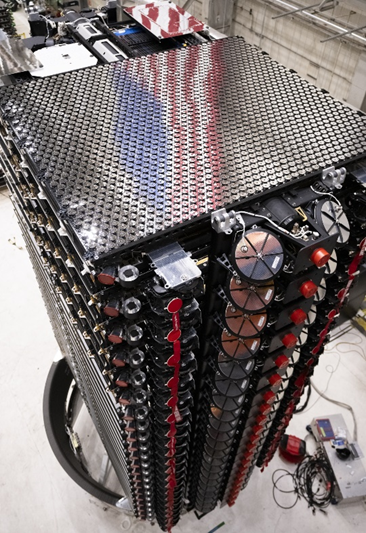The company's technologies allow the smartphone to connect directly to satellites.
SpaceX has made a breakthrough in the field of satellite communications, launching the first batch of Starlink satellites into orbit that can directly transmit a signal to smartphones. The Falcon 9 mission was successfully launched on January 2 from Vandenberg Air Force Base in California.
In total, 21 satellites were delivered to low-Earth orbit, of which 6 are equipped with innovative modems that function as space cell towers, which allows you to implement the function of direct communication with mobile devices. T-Mobile will be the first carrier in the United States to offer the new "Coverage Above and Beyond" service.

Satellites with modems
Immediately after entering orbit, the satellites began transmitting data from the Starlink satellite network using lasers, providing solid coverage, increased Internet speed and reduced latency. It is expected that Starlink will start working in places where the cellular signal usually disappears, working in a similar way to roaming.
In addition to T-Mobile, the Starlink Direct to Cell service has been joined by the world's leading telecom operators, including Optus in Australia, Rogers Communications in Canada, KDDI in Japan, One NZ in New Zealand, Salt in Switzerland, and Entel in Chile and Peru.
The collaboration between SpaceX and T-Mobile was announced in August 2022 as a means of providing affordable cellular service in remote and hard-to-reach areas. SpaceX notes that thousands of square kilometers of the United States and the vast expanses of the oceans are still not covered by cellular signals, which forced users to face signal loss or the need to use expensive satellite phones.
The Starlink mission was the 285th flight of the Falcon 9. This 70-meter rocket is the world's first orbital reusable rocket designed to safely transport people and cargo to and from Earth's orbit. SpaceX is already preparing for the next Falcon 9 launch within 24 hours for the Ovzon 3 mission from the Canaveral Space Center in Florida, which will head to a geosynchronous transition orbit. The event not only highlights the company's technological progress, but also opens up new horizons in the field of mobile communications.
The first Starlink satellites with laser communication were launched back in 2021. They provided Internet services in Alaska, where installing ground stations was problematic. The stations serve as intermediaries between Starlink satellites and data centers. However, a new technology called Optical Intersatellite Links allows satellites to communicate with each other directly using lasers, which increases internet speed and reduces latency.
SpaceX has made a breakthrough in the field of satellite communications, launching the first batch of Starlink satellites into orbit that can directly transmit a signal to smartphones. The Falcon 9 mission was successfully launched on January 2 from Vandenberg Air Force Base in California.
In total, 21 satellites were delivered to low-Earth orbit, of which 6 are equipped with innovative modems that function as space cell towers, which allows you to implement the function of direct communication with mobile devices. T-Mobile will be the first carrier in the United States to offer the new "Coverage Above and Beyond" service.

Satellites with modems
Immediately after entering orbit, the satellites began transmitting data from the Starlink satellite network using lasers, providing solid coverage, increased Internet speed and reduced latency. It is expected that Starlink will start working in places where the cellular signal usually disappears, working in a similar way to roaming.
In addition to T-Mobile, the Starlink Direct to Cell service has been joined by the world's leading telecom operators, including Optus in Australia, Rogers Communications in Canada, KDDI in Japan, One NZ in New Zealand, Salt in Switzerland, and Entel in Chile and Peru.
The collaboration between SpaceX and T-Mobile was announced in August 2022 as a means of providing affordable cellular service in remote and hard-to-reach areas. SpaceX notes that thousands of square kilometers of the United States and the vast expanses of the oceans are still not covered by cellular signals, which forced users to face signal loss or the need to use expensive satellite phones.
The Starlink mission was the 285th flight of the Falcon 9. This 70-meter rocket is the world's first orbital reusable rocket designed to safely transport people and cargo to and from Earth's orbit. SpaceX is already preparing for the next Falcon 9 launch within 24 hours for the Ovzon 3 mission from the Canaveral Space Center in Florida, which will head to a geosynchronous transition orbit. The event not only highlights the company's technological progress, but also opens up new horizons in the field of mobile communications.
The first Starlink satellites with laser communication were launched back in 2021. They provided Internet services in Alaska, where installing ground stations was problematic. The stations serve as intermediaries between Starlink satellites and data centers. However, a new technology called Optical Intersatellite Links allows satellites to communicate with each other directly using lasers, which increases internet speed and reduces latency.
